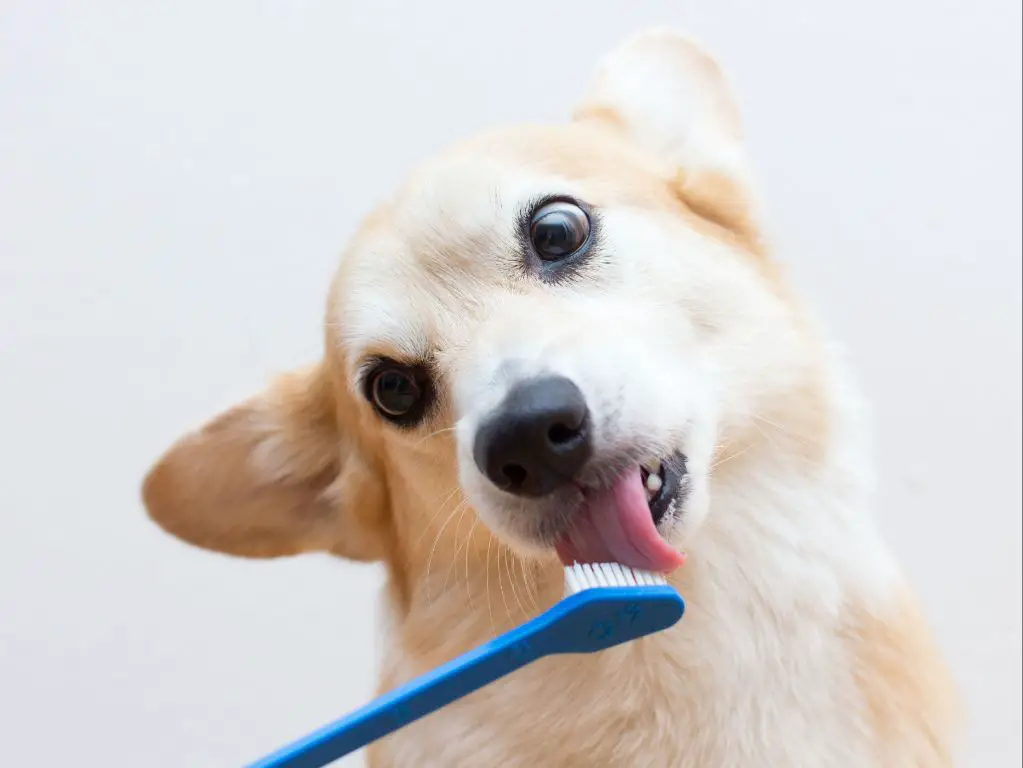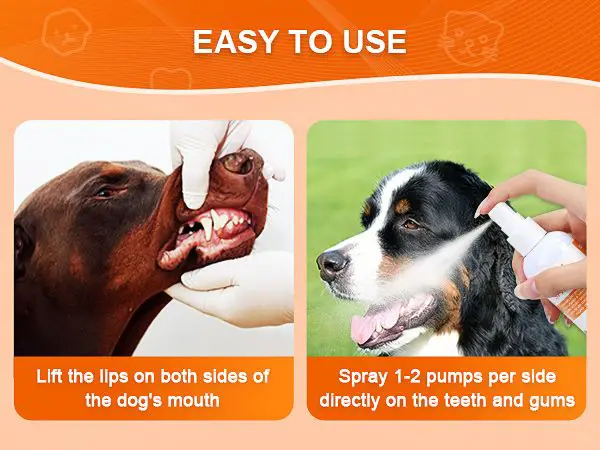Dangers of Plaque Buildup in Dogs
Plaque buildup can be very dangerous for your dog’s oral health and overall wellbeing. Plaque contains bacteria that can lead to gum disease and tooth decay if not removed regularly. As plaque builds up, it hardens into tartar that sticks to the teeth. This can cause gingivitis and periodontitis, which are infections of the gums and roots of the teeth.
If left untreated, these dental diseases can become extremely painful for dogs and lead to tooth loss. The bacteria from plaque and tartar can also spread through the bloodstream, potentially affecting the heart, kidneys, and liver. Smaller dog breeds tend to have more issues with plaque buildup and dental disease.
That’s why it’s so important to take measures to prevent plaque in dogs. Removing plaque regularly can help avoid dental infections, tooth loss, and damage to internal organs. Keeping your dog’s teeth clean isn’t just about cosmetics – it’s essential for protecting their health and wellbeing.
Regular Brushing
Regular brushing is the most effective method for removing plaque from your dog’s teeth. Using a soft-bristled toothbrush designed for dogs along with toothpaste made specifically for canines is crucial.

Dog toothpaste contains enzymes that help break down plaque and ingredients that are safe if swallowed. Human toothpaste can upset your dog’s stomach and should never be used. It’s best to start slow with brushing and gradually build up to daily cleaning.
Begin by letting your dog sample the toothpaste flavor and get used to you handling their mouth. Gently rub the brush on the outer surfaces of their teeth, working up to brushing the inner surfaces as they become more comfortable. Spend at least 30 seconds per side.
Work up to daily brushing sessions to keep your dog’s teeth pearly white and plaque-free. Regular brushing is the gold standard for canine dental care and the most effective way to remove plaque naturally.
Dental Chews
Dental chews for dogs can help scrape plaque off their teeth as they chew. The mechanical action of chewing works to physically remove buildup from the tooth surfaces. Look for dental chews that carry the VOHC (Veterinary Oral Health Council) seal of approval, which means they have been tested and proven clinically effective.
Some popular VOHC approved dental chew options include Greenies, CET chews, and OraVet chews. They come in a variety of flavors, textures, and sizes to appeal to different dogs’ preferences.
It’s important to always supervise your dog when giving any kind of chew treat. Make sure they are chewing thoroughly and don’t attempt to swallow large pieces, which could present a choking hazard.
Dental chews should not replace regular toothbrushing, but can provide a boost in keeping your dog’s teeth clean when used consistently.

Fresh Foods
Feeding your dog fresh foods that are abrasive in texture can help scrape away plaque buildup on their teeth. Hard, raw bones act like toothbrushes for dogs by physically scraping off tartar. Raw carrot and apple slices also rub against the teeth to remove plaque. These foods are safe and healthy options for your dog to chew on.
Some fresh fruits and vegetables are particularly beneficial for your dog’s oral health. Broccoli contains vitamin C which promotes healthy gums. Sweet potatoes are high in vitamin A and beta-carotene, which improve overall dental health. Adding a tablespoon of oil like coconut or olive oil to your dog’s dry kibble can also help prevent plaque buildup.
Water Additives
Adding plaque-fighting ingredients to your dog’s drinking water can be an effective way to help remove plaque buildup naturally. There are several commercial water additives that contain ingredients like chlorhexidine, zinc gluconate, grapefruit seed extract, and enzymes that help prevent bacteria growth in your dog’s mouth.
When your dog drinks water containing these ingredients, it helps loosen existing plaque and prevent further buildup. The ingredients get dispersed throughout your dog’s mouth, coating the teeth and gums. This makes it more difficult for plaque to adhere.
Before trying a water additive, it’s a good idea to have your vet examine your dog’s teeth first. Significant plaque buildup can be a sign of periodontal disease, which requires professional dental cleaning and treatment. Water additives help with maintenance after addressing any underlying issues.
Dental Sprays
Dental sprays can be another useful tool for removing plaque from your dog’s teeth naturally. These sprays contain enzymes that help break down and dissolve plaque so that your dog can then swallow or spit it out. Many dental sprays for dogs contain ingredients like glucose oxidase, lactoperoxidase, lysozyme, or papain.
To use a dental spray, simply spritz it into your dog’s mouth, targeting areas where plaque has built up like the gumline, teeth surfaces, and around the cheeks. Let your dog lick its chops for a bit to spread the spray around before letting it swallow. The enzymes will help loosen and dissolve plaque so it can be easily removed. Dental sprays work best if used in conjunction with brushing your dog’s teeth. You can spray on the plaque softening solution, let it sit for a minute, then brush away the loosened plaque. Using a dental spray makes the brushing process more effective.

Look for a dog dental spray that is formulated to be safe if swallowed, and follow the usage directions. Using a dental spray can help break up plaque and keep your dog’s teeth cleaner between brushings. But be sure to still brush regularly as the mechanical action of brushing is important for removing plaque buildup on teeth.
Professional Cleaning
If plaque buildup becomes severe, your vet may recommend a professional dental cleaning. This is done under anesthesia so your dog remains still and comfortable during the process.
The vet will use dental scaling tools to thoroughly scrape away stubborn tartar above and below the gumline. In cases of advanced periodontal disease, the vet may need to extract damaged teeth that cannot be saved.
Professional cleanings allow the vet full access to all surfaces of the teeth, down to the roots. This is the only way to fully remove plaque below the gumline that causes periodontitis. Regular cleanings help keep your dog’s teeth and gums healthy.
Homemade Remedies
There are several natural homemade remedies you can try to help remove plaque from your dog’s teeth:
Coconut Oil – Coconut oil contains lauric acid which has natural antiviral, antibacterial and antifungal properties. Giving your dog coconut oil can help kill bacteria in their mouth. Add a teaspoon of coconut oil to their food daily.
Diluted Hydrogen Peroxide – Creating a solution of half hydrogen peroxide and half water can make an effective doggie mouthwash. Use a soft brush or piece of cloth to gently swab the solution on your dog’s teeth. Be very careful not to swallow any of the solution.
Oregano Oil – Oregano oil is a natural antiseptic that can kill plaque-causing bacteria. Add a few drops of oregano oil to your dog’s water bowl when refilling. Be sure to regularly change the water to prevent bacteria growth.
Plaque Prevention Tips
Preventing plaque buildup in the first place is the best way to keep your dog’s teeth clean and healthy. Here are some tips for preventing plaque:
Yearly vet dental exams – Take your dog to the vet every year for a professional dental exam and cleaning if needed. The vet can scale plaque and tartar off areas that are hard to reach at home.
Brush regularly – Brushing your dog’s teeth at least 2-3 times a week will prevent plaque from hardening into tartar. Use dog-safe toothpaste and a soft brush designed for dogs.
Dental chews and toys – Chews and toys designed to clean teeth can scrub away soft plaque. Look for textured chews made specifically for dental health.
Probiotics – Probiotic supplements support digestive and immune health. Some studies also show certain strains may reduce plaque and bad breath in dogs.
With diligent home care and professional cleanings as needed, you can keep your dog’s teeth clean and plaque-free.
When to See the Vet

Plaque buildup can lead to serious dental disease in dogs if left untreated. Signs that it’s time to take your dog to the vet include:
- Red or inflamed gums – This indicates gingivitis or gum infection.
- Yellow or brown buildup on teeth – Tartar, or hardened plaque, needs professional cleaning.
- Bad breath – Persistent bad breath usually signals a dental issue.
- Loose teeth – Advanced gum disease can cause teeth to loosen or fall out.
- Reduced appetite – Mouth pain from plaque or tartar may cause a dog to stop eating.
If you notice any of these symptoms, schedule a veterinary dental exam right away. The vet will assess your dog’s oral health, clean accumulated tartar from the teeth, and recommend any needed treatment. Addressing plaque before it turns into tartar helps prevent gum disease, infections, tooth loss, and other problems down the road.